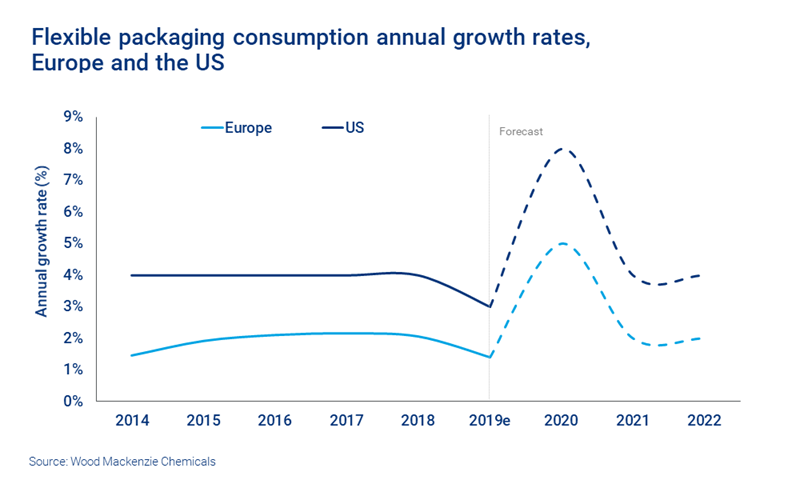Flexible packaging sees demand boost as coronavirus changes consumer patterns
Lockdown measures are sending home consumption skywards
1 minute read
Rob Gilfillan
Head of Polymer & Fibres

Rob Gilfillan
Head of Polymer & Fibres
Rob leads our research into regional and global markets for fibres, films and flexible packaging.
Latest articles by Rob
-
Featured
Oils & chemicals 2025 outlook
-
Opinion
Plastic demand could reduce by up to 30% in an accelerated energy transition scenario
-
Opinion
Plastic demand: sectoral overview
-
Opinion
The future of automotive industry polymer demand
-
Opinion
Polymer demand scenarios: a little more conversation, a little less plastic
-
Featured
Global challenges weigh on downstream chemical markets in 2023
In an attempt to slow the spread of the coronavirus outbreak, governments worldwide have introduced social isolation measures that have fundamentally changed modern living. These new restrictions on daily life have had a huge impact on how we consume FMCG goods. The freedom to eat out at a restaurant or simply to do the weekly food shop is either severely hampered, or impossible. The speed at which governments have introduced these measures is unprecedented, and many sectors of the food processing industry are being forced to quickly adapt to a rapid change in consumer behaviour as a result.
How have consumption patterns changed?
Lockdown measures naturally caused a wave of panic buying and stockpiling across Europe and North America. In addition, the sudden lack of choice around how and where we consume food has also forced huge volumes of food consumption away from the food service sector (restaurants, cafés etc) and through the retail sector, which naturally favours pre-packaged food in smaller, consumer-sized packaging.
In Europe, we have also seen demand for ambient foods (such as pastas, rice and flour) double or even triple over the outbreak period, although we are now seeing sales levelling off. Frozen foods have also reported a significant increase in demand, but will likely plateau as we approach summer. Demand for comfort foods, such as chocolate and confectionery, baked goods and biscuits, as well as alcohol and tobacco, has also risen, as people tend to turn to these products in times of stress.
In the US, coffee is in high demand with consumption estimated to be at least 50% higher than typical for this time of year. Related packaging growth is focused in high-quality, high-value printed laminates for the retail market. Converters manufacturing unprinted flexible packaging for the meat and cheese sector are also reporting higher than usual orders.
And, of course, the coronavirus outbreak is a major health crisis, so the healthcare sector has also been heavily impacted. Demand for flexible packaging in medical supplies, such as gowns and swabs, has seen double-digit growth over the outbreak period.
How big is the demand boost for the US and Europe?
We are already seeing the effect of the consumption boost flowing through the supply chain. Converters have pre-ordered large volumes of plastic film, anticipating a shortage in flexible packaging raw materials. Biaxially-oriented PET (BOPET) film producers in both Europe and the US, for example, are reporting an uplift in bulk orders from packers looking to meet increased demand.
As a result, we expect flexible packaging consumption in both Europe and the US to see a material uplift in the short term. This will be followed by a slight easing as we move through the year, as social isolation measures are slowly lifted.
After a disappointing 2019 in both regions, we expect to see US demand for consumer flexible packaging increase by high single digits this year, compared to 3% in 2019. In Europe, demand growth fell back to under 1.5% in 2019, but could climb to above 5% this year.
It is, however, important to note that these projections are dependent on the extent of the current lockdown which could materially change if we see an extended period of isolation.
The coronavirus outbreak could also spark an increase in China’s low per capita consumption of flexible packaging. You can read about this in ‘Could flexible packaging reduce the threat of future outbreaks?’
Can the supply chain cope?
One area of concern is fragility in the supply chain. Sourcing of flexible packaging raw materials is currently holding up – bar the availability of solvents, which is causing ink manufacturers some logistical issues. Transportation costs have risen sharply, acting as the main cost driver for an increase in European BOPET film prices in March.
Constrained food supply could pose another risk. The impact of lockdown measures on the workforce is a cause for concern. For example, will restrictions on the movement of workers result in a lack of fruit and vegetable pickers?
And will the coronavirus outbreak affect the sustainability agenda?
Packaging sustainability was a major talking point coming into 2020. It has taken a back seat during this crisis but will obviously come back to prominence once the current situation eases.
However, it is worth noting that if crude oil prices remain low, the use of virgin plastic will be a very attractive proposition compared to more expensive post-consumer-recycled content. The post-coronavirus world will undoubtedly be very cost-conscious.
Interested in the flexible packaging market?
Our Flexible Packaging European Annual Supply Demand Report is coming soon, and will include our 2019 review and five year forecast. Fill in the form at the top of this page for a copy of the preview brochure and table of contents.








